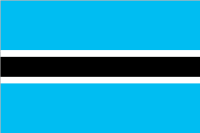Aug 23 2012
Topics Covered
Welcome to Botswana
Overview of Resources
Industrial Minerals and Gemstones
Metals
Fossil Fuels
Investment
Sources
Welcome to Botswana
Botswana is a country located in Southern Africa. The total area of the country is 581,730 km2 with a population of 2,098,018 as of July 2011. Its climate is mostly semiarid.
 |
The national flag of Botswana.
Image Credit: CIA Factbook. |
Botswana gained independence in 1966. Since then it has grown to become one of the most active economies in Africa with a stable government, substantial capital investment, and good social reforms. The country is currently battling unemployment and AIDS, which are hampering economic growth.
Botswana is abundant in natural resources such as diamonds, silver, copper, nickel, coal soda ash, potash, and iron ore. Almost 70-80% of export earnings are attributed to diamond mining. The mining sector of the country, especially diamond mining, plays a dominant role in its economy. The global downturn of 2009 greatly decreased the demand for Botswana's diamonds. In the recent years, Botswana has transformed itself into a middle-income country with the GDP amounting to $30.09 billion in 2011.
Overview of Resources
Botswana is a country rich in a variety of mineral resources with diamond being the most significant resource since its discovery in 1967. The Jwaneng open pit mine in the country is considered as the richest diamond mine in the world based on the measured value of recovered diamond.
Unexploited mineral resources, such as gypsum, iron, asbestos, feldspar, chromium, graphite, and manganese, are located in remote areas and below the Kalahari sands.

The map of Botswana. Image Credit: CIA Factbook.
Industrial Minerals and Gemstones
Botswana’s diamond production increased to 21 million carats in 2010 compared to 17.7 million carats in 2009, and diamond export value crossed $2.94 billion. Debswana Diamond Co. (Pty) Ltd was responsible for almost all the rough diamond production along with about 30,000 kg of semiprecious stones. The company is jointly owned by the Botswana government and De Beers Group of South Africa, and tops diamond production in the world. The Damtshaa, Jwaneng, Letlhakane, and Orapa mines are owned by Debswana with the Orapa mine being the second largest diamond-producing mine. Further expansion work is planned for the Jwaneng Mine at a cost of $3 billion, which would be the single largest investment in the mineral sector in Botswana. This expansion operation would prolong service life of the Jwaneng mine by seven years from 2017 to 2024.
Gem Diamonds Ltd. of UK has been granted a license for 25 years to conduct mining activities in the Gope deposit in the Central Kalahari Game Reserve. The Gope deposit is said to contain about 20.5 million carats of diamonds worth about $3.3 billion.
Metals
Gold production by IMAGOLD Corp. was estimated at 1,800 kg in 2010 compared to that of 1,626 kg in 2009.
Hana Mining Ltd. of Canada has discovered vast copper and silver ore deposits over an area of 2,200 km2 via its Ghanzi project.
In 2010, Tati Nickel Mining Co. (Pty.) Ltd. of Russia produced 28,000 Mt of nickel, 14,000 t of copper, and 340 t of cobalt from the mining and processing operations conducted at Selebi-Phikwe.
Fossil Fuels
CIC Energy Corp. has been performing mining operations in the the Mmamabula coal deposit and power station. The deposit is said to contain 2,800 Mt of coal. In 2010, JSW Energy Ltd. of India had offered to takeover all the shares of the company for a whopping $414 million.
The Sese project of African Energy Resources Ltd. of Australia located in northeastern Botswana mainly produces uranium. A-Cap Resources Ltd. of Canada has also conducted exploration operations after discovering a near-surface secondary uranium mineralization zone. The Letlhakane project of the company completed construction of Botswana’s first uranium mine.
Investment
Ever since Botswana recovered from the global downturn of 2009, revenues from diamond operations have been steadily increasing. Experts believe that global interest in diamond, base and precious metals, and uranium explorations will continue in the near future.
Botswana’s mineral exploration and mining operations are regulated by the Department of Geological Survey and the Department of Mines under the Ministry of Minerals, Energy and Water Resources (MMEWR). The Department of Mines along with stakeholders lists out policies, provides administrative services, formulates programs, and drafts legislation for mineral exploration. It also works towards prevention of occupational diseases and injuries related to mining and minimizing degradation of the environment.
Botswana is a member of the Kimberley Process Certification Scheme (association of commercial diamond firms, industry associations, diamond-producing and-importing countries, and nongovernmental organizations), for forming a proper certification system for international trading of rough diamond, so as to stop the ‘blood’/’conflict’ diamonds from being traded via legitimate trading lines.
International mining group Anglo American stated recently that it will raise its stake in the diamond company De Beers to 85% as Botswana has withdrawn its pre-emptive rights. Botswana, which owns 15% of De Beers, let go its right to buy another 25% for $1.275 billion. This has helped strengthen the longstanding ties between Anglo American and Botswana.
The country already has many international investors with active mineral exploration projects. Gold, copper, nickel, and soda ash production will continue to play a positive role in the country’s economy. With the domestic demand for power increasing constantly, coal reserves will likely be explored more extensively and coal-fuelled electricity-generating plants are also expected to be constructed.
Botswana’s mineral industry is on the right path to a brighter future with the country slowly becoming a preferred foreign investment destination thanks to its favorable mineral investment environment, low tax rates and political stability.
Disclaimer: The Author of this article does not imply any investment recommendation and some content is speculative in nature. The Author is not affiliated in any way with any companies mentioned and all statistical information is publically available.
Sources